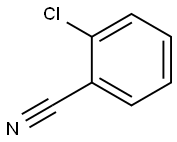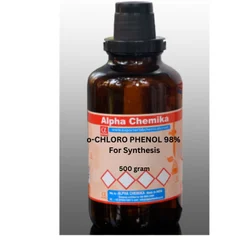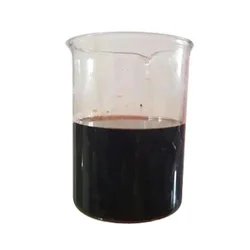2-Chlorophenol
Synonym(s):2-Chloro-1-hydroxybenzene;2-Chlorophenol
- CAS NO.:95-57-8
- Empirical Formula: C6H5ClO
- Molecular Weight: 128.56
- MDL number: MFCD00002159
- EINECS: 202-433-2
- SAFETY DATA SHEET (SDS)
- Update Date: 2025-12-10 11:56:18

What is 2-Chlorophenol?
Description
All have a characteristic odor. Odor threshold =1.24 ppm (pure). Molecular weight (all isomers) =128.56.m-isomer
Colorless (in pure state) to pink or amber (technical grade,due to impurities) crystalline solid or liquid. Boilingpoint =214℃; Freezing/Melting point =32.8℃; Specificgravity (H2O:1) =1.245; Vapor pressure =5 mmHg at70℃; Flash point =112℃. Solubility in water=2.6-2.8.5% at 20℃. Hazard Identification (based onNFPA 704 M Rating System): Health 2, Flammability 0,Reactivity 0.
o-isomerWhite crystalline (needle-like) solid. Boilingpoint =175.6℃; Freezing/Melting point =9.3-9.8℃;Specific gravity (H2O:1) =1.3; Vapor pressure, Pa at20℃ =230; Relative vapor density (air =1) =4.4; Flashpoint =64℃ (cc). Hazard Identification (based on NFPA704 M Rating System): Health 3, Flammability 2,Reactivity 0. Solubility in water =2.7% at 20℃.p-isomer
White to straw-colored, needle-like crystalline solid.Boiling point =218℃; Freezing/Melting point =43℃;Vapor pressure =10 mmHg at 20℃; Vapor density (air=1) =4.44; Flash point = 121℃ (cc). HazardIdentification (based on NFPA 704 M Rating System):Health 3, Flammability 1, Reactivity 0. Solubility inwater =2.71% at 20℃.
Chemical properties
2-Chlorophenol is a colourless to light brown liquid, All isomers have a characteristic odor. Slightly soluble in water, soluble in ethanol, ether and alkali solution. It is used to make dyes and other chemicals, and as a disinfectant, bactericide, and germicide.
Physical properties
Pale amber liquid with a slight phenolic, floral, or musty-type odor. At 40 °C, the average and lowest odor concentrations detected were 0.36 and 0.088 μg/L, respectively. At 25 °C, the average taste threshold concentration and the lowest concentration at which a taste was detected were 0.97 and 0.94 μg/L, respectively (Young et al., 1996).
The Uses of 2-Chlorophenol
2-Chlorophenol is used to synthesize various organic intermediates and compounds including several polycyclic aromatic hydrocarbons and pharmacologically active molecules. It is used as a precursor to synthesize polychlorinated dibenzo p-dioxins and dibenzofurans (PCDD/Fs).
What are the applications of Application
2-chlorophenol is used in medicine, pesticides, dyes and organic synthesis. It is an intermediate in the production of the pesticides Profenofos and Isoprocarb. It is also utilized in the manufacture of dye-stulfs and in the process for extracting sulphur and nitrogen compounds from coal. 2-chlorophenol functions as a reagent in the preparation of chlorophenyl phosphorodichloridothioate as potential synthon for oligonucleotide phosphorothioates.
Preparation
2-chlorophenol is produced in 22% yields from the reaction of chlorine monoxide with phenol in carbon tetrachloride: 0.5 mole of tert-butyl hypochlorite is dropped, with stirring, into a solution or suspension of the 0.5 mole of phenol in 150-300 ml of carbon tetrachloride, the temperature being allowed to rise to the boiling point of the solvent. The mixture is then boiled under reflux for a further 2 hours, the carbon tetrachloride and the tert-butyl alcohol are distilled off, and the residue is fractionated collecting fraction boiling at 174.9 °C.
Definition
ChEBI: 2-chlorophenol is a monochlorophenol and a 2-halophenol.
Synthesis Reference(s)
The Journal of Organic Chemistry, 35, p. 528, 1970 DOI: 10.1021/jo00827a060
Tetrahedron Letters, 29, p. 1319, 1988 DOI: 10.1016/S0040-4039(00)80287-7
General Description
2-chlorophenol appears as a colorless to amber liquid with an unpleasant, penetrating odor. Density 1.265 g / cm3. Sinks in water and slowly dissolves. Freezing point 7°C (46°F). Boiling point 175°C (347°F).
Air & Water Reactions
Very soluble in water
Reactivity Profile
2-Chlorophenol is a weak acid. Neutralizes bases in exothermic reactions. Incompatible with oxidizing agents. Incompatible with acid chlorides and acid anhydrides. Forms ethers, esters and salts with metals and amines .
Hazard
Toxic by skin absorption, inhalation, or ingestion. Strong irritant to tissue.
Health Hazard
Poisonous; may be fatal if inhaled, swallowed or absorbed through skin. Irritating to skin and eyes; direct contact may cause burns. Rats receiving lethal doses via oral, subcutaneous or intraperitoneal routes displayed similar symptoms: restlessness, increased breathing rate and motor weakness followed by tremors, chronic convulsions, dyspnea, coma and death.
Safety Profile
Poison by ingestion, intraperitoneal, and intravenous routes. Experimental reproductive effects. Questionable carcinogen with experimental tumorigenic data. Mutation data reported. Flammable liquid when exposed to heat, flame, or oxidizers. To fight fire, use alcohol foam. When heated to decomposition it emits toxic fumes of Cl-. See also CHLOROPHENOLS and CHLORIDES.
Potential Exposure
Monochlorophenols are used in the manufacture of fungicides, slimicides, bactericides, pesticides, herbicides, disinfectants, wood and glue preservatives; in the production of phenolic resins; in the extraction of certain minerals from coal; as a denaturant for ethanol; as an antiseptic; as a disinfectant, and others.
First aid
If this chemical gets into the eyes, remove anycontact lenses at once and irrigate immediately for at least15 min, occasionally lifting upper and lower lids. Seek medical attention immediately. If this chemical contacts theskin, remove contaminated clothing and wash immediatelywith soap and water. Seek medical attention immediately. Ifthis chemical has been inhaled, remove from exposure,begin rescue breathing (using universal precautions, including resuscitation mask) if breathing has stopped and CPR ifheart action has stopped. Transfer promptly to a medicalfacility. When this chemical has been swallowed, get medical attention. Give large quantities of water and inducevomiting. Do not make an unconscious person vomit.
Storage
Color Code—Blue: Health Hazard/Poison: Storein a secure poison location. Prior to working with chlorophenols you should be trained on its proper handling andstorage. Before entering confined space where chlorophenols may be present, check to make sure that an explosiveconcentration does not exist. Store in tightly closed containers in a cool, well-ventilated area. Metal containers involving the transfer of this chemical should be grounded andbonded. Where possible, automatically pump liquid fromdrums or other storage containers to process containers.Drums must be equipped with self-closing valves, pressurevacuum bungs, and flame arresters. Use only nonsparkingtools and equipment, especially when opening and closingcontainers of this chemical. Sources of ignition, such assmoking and open flames, are prohibited where this chemical is used, handled, or stored in a manner that could createa potential fire or explosion hazard. A regulated, markedarea should be established where this chemical is handled,used, or stored in compliance with OSHA Standard1910.1045.
Shipping
UN 2020 (solid); UN2021 (liquid) Chlorophenols, solid and liquid, Hazard Class: 6.1; Labels: 6.1-Poisonous materials.
Purification Methods
Pass 2-chlorophenol at least twice through a gas chromatography column. It has also been purified by fractional distillation. [Beilstein 6 IV 782.]
Incompatibilities
May form explosive mixture with air. Contact with oxidizing agents can cause fire and explosion hazard. Heat produces hydrogen chloride and chlorine. Corrosive to aluminum, copper and other chemically active metals.
Waste Disposal
Incinerate in admixture with flammable solvent in furnace equipped with afterburner and scrubber.
Properties of 2-Chlorophenol
| Melting point: | 8 °C (lit.) |
| Boiling point: | 175-176 °C (lit.) |
| Density | 1.241 g/mL at 25 °C (lit.) |
| vapor pressure | 13.3 hPa (50 °C) |
| refractive index | n |
| Flash point: | 147 °F |
| storage temp. | under inert gas (Argon) |
| solubility | alcohol: freely soluble |
| form | neat |
| pka | 8.49(at 25℃) |
| color | Clear Colourless to Pale Orange |
| Water Solubility | 28.5 g/L (20 ºC) |
| Merck | 14,2154 |
| BRN | 1905114 |
| Henry's Law Constant | 6.44 x 10-6 atm?m3/mol at 20 °C (Sheikheldin et al., 2001) |
| Dielectric constant | 8.2(19℃) |
| Stability: | Stable. Hygroscopic. Combustible. Incompatible with oxidizing agents, acid anhydrides, acid chlorides. |
| CAS DataBase Reference | 95-57-8(CAS DataBase Reference) |
| NIST Chemistry Reference | 2-Chlorophenol(95-57-8) |
| EPA Substance Registry System | o-Chlorophenol (95-57-8) |
Safety information for 2-Chlorophenol
| Signal word | Danger |
| Pictogram(s) |
 Corrosion Corrosives GHS05  Skull and Crossbones Acute Toxicity GHS06  Environment GHS09 |
| GHS Hazard Statements |
H302:Acute toxicity,oral H314:Skin corrosion/irritation H411:Hazardous to the aquatic environment, long-term hazard |
| Precautionary Statement Codes |
P273:Avoid release to the environment. P280:Wear protective gloves/protective clothing/eye protection/face protection. P301+P312:IF SWALLOWED: call a POISON CENTER or doctor/physician IF you feel unwell. P303+P361+P353:IF ON SKIN (or hair): Remove/Take off Immediately all contaminated clothing. Rinse SKIN with water/shower. P305+P351+P338:IF IN EYES: Rinse cautiously with water for several minutes. Remove contact lenses, if present and easy to do. Continuerinsing. |
Computed Descriptors for 2-Chlorophenol
| InChIKey | ISPYQTSUDJAMAB-UHFFFAOYSA-N |
2-Chlorophenol manufacturer
Kavya Pharma
New Products
4,4-Difluoropiperidine hydrochloride tert-butyl 9-methoxy-3-azaspiro[5.5]undecane-3-carboxylate Indole Methyl Resin N-Isopropylurea N,N-Dicyclohexylcarbodiimide(DCC) MELDRUMS ACID 5-METHYLISOXAZOLE-4-CARBOXYLIC ACID Magnessium Bis glycinate Zinc ascorbate 1-bromo-2-butyne 2-acetamidophenol 9(10H)-anthracenone Erythrosin B, 4-Piperidinopiperidine 2-((4-morpholinophenylamino) (methylthio) methylene) malononitrile 2,4-dihydroxybenzaldehyde 3-(4-morpholinophenylamino)-5-amino-1H-pyrazole-4-carbonitrile Methyl 2-methylquinoline-6-carboxylate 2,6-dichloro-4-nitropyridine 4-Bromo-2-chlorobenzonitrile 2-(benzylamino)acetic acid hydrochloride 4-(tert-Butoxycarbonylamino)but- 2-ynoic acid 3,4-dihydro-2H-benzo[b][1,4]dioxepine 1-Phenyl-1-cycloprppanecarboxylicacidRelated products of tetrahydrofuran








You may like
-
 ORTHO CHLORO PHENOL 99%View Details
ORTHO CHLORO PHENOL 99%View Details -
 2-Chlorophenol 98%View Details
2-Chlorophenol 98%View Details -
 2-Chlorophenol 99%View Details
2-Chlorophenol 99%View Details -
 2-Chlorophenol, 98+% CAS 95-57-8View Details
2-Chlorophenol, 98+% CAS 95-57-8View Details
95-57-8 -
 o-Chlorophenol pure CAS 95-57-8View Details
o-Chlorophenol pure CAS 95-57-8View Details
95-57-8 -
 Liquid 2- Chlorophenol SynthesisView Details
Liquid 2- Chlorophenol SynthesisView Details
95-57-8 -
 95-57-8 Ortho Chlorophenol Liquid, Purity: 98%View Details
95-57-8 Ortho Chlorophenol Liquid, Purity: 98%View Details
95-57-8 -
 Ortho Chloro phenol, For Laboratry, Grade: TechnicalView Details
Ortho Chloro phenol, For Laboratry, Grade: TechnicalView Details
95-57-8
